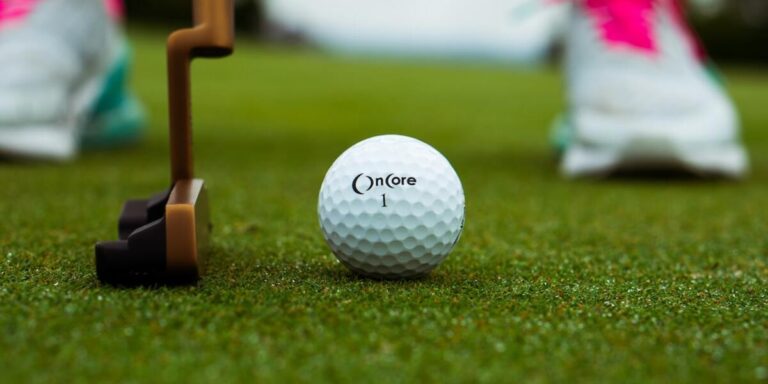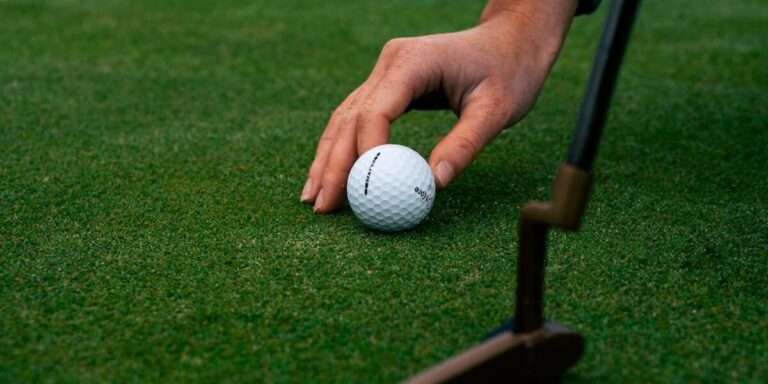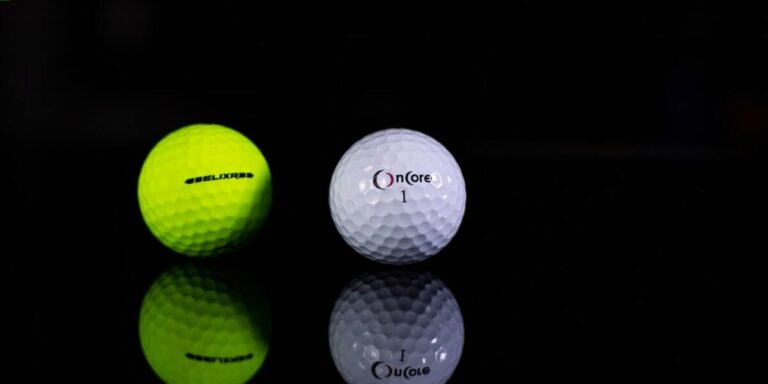Why do golf balls have 336 dimples?
According to Golf Digest, the average golf ball has 336 dimples. That number may seem random, but there’s actually a lot of science that goes into designing golf balls. Dimples help reduce drag and add lift, which ultimately results in more distance.
So how many dimples are on a golf ball? The answer is it depends. Different manufacturers have different designs, and some even experiment with different numbers of dimples (within reason). Ultimately, it comes down to what delivers the best results for each company’s products.
The History of Golf Balls and Their Dimples
The game of golf has been around for centuries, and the design of the golf ball has undergone a lot of evolution over that time. The first golf balls were made of wood or leather and filled with feathers, which made them very light and aerodynamic. These early balls didn’t have any dimples, but they did have grooves on their surface which helped to give them spin.
As technology progressed, people began experimenting with different materials for golf balls, including Gutta-percha (a type of rubber) and balata (a natural gum resin). These new materials allowed manufacturers to create much harder golf balls than before, which led to the development of the modern smooth-surfaced ball we use today. Dimples were first introduced in 1898 as a way to help these new hard gutta-percha balls travel further through the air.
Since then, there have been many different designs and variations of dimpled golf balls created by manufactures all over the world. The number of dimples on a golf ball can vary from just a few dozen to hundreds! And while it’s impossible to say definitively what is the “ideal” number ofdimples on a golf ball, having too few or too many can definitely impact its performance. So next time you’re out on the course teeing up your ball, take a moment to appreciate all those tiny little dimples – they play an important role in helping you get that perfect shot!
How Many Dimples Are on a Golf Ball?
How many dimples are on a golf ball? It’s a question that has been debated by golfers for years. Some believe that thedimples on a golf ball help to aerate the ball and keep it from going as far off course. Others believe that there are an optimum number of dimples on a golf ball, which helps to increase its accuracy.
So, how many dimples are on a golf ball? The answer may surprise you. According to most experts, there are between 340 and 350 dimpleson a regulation size golf ball. That means that if you’re looking for maximum distance, you should choose aball with fewer dimples. If accuracy is your goal, then aim for one with moredimples.
Interestingly enough, the very first Golf balls had no dimple at all! It wasn’t until 1898 that Rev Dr Robert Adams Paterson createdthe first prototype of the modern-day Golf Ball by punching Dimple into gutta-perchaballs – he did this in his kitchen! Since then, manufacturers have experimentedwith different numbers of Dimple patterns on Golf balls in order to find the perfect combinationfor bothdistance and accuracy
Why Do Golf Balls Have 336 Dimples?
Golf balls have been around for centuries, and their evolution has been fascinating to watch. The game of golf is thought to have originated in Scotland in the 15th century, and the first recorded mention of a golf ball was in 1457. Since then, golf balls have undergone a tremendous transformation. Early golf balls were made from hardwoods like beech and boxwood; later ones were crafted from leather stuffed with goose feathers. The modern golf ball as we know it began to take shape in the late 1800s when rubber became the material of choice.
So why do golf balls have 336 dimples? It all has to do with aerodynamics. Dimples on a golf ball help reduce drag by turbulent airflow and increase lift by creating a thin layer of turbulent air that clings to the surface of the ball (a phenomenon known as boundary layer control). This allows the ball to travel further through the air before being slowed down by drag forces. So more dimples means more distance!
Interestingly, not all Golf Balls are created equal! Some manufacturers experiment with different numbers of dimples or different shapes altogether- so if you’re looking for an edge on your opponents, doing some research on which type of ball might work best for you is definitely warranted!
The Function of Dimples on a Golf Ball
Dimples on a golf ball serve an important function – they help to reduce drag and improve aerodynamics. When a ball is hit, the air around it begins to spin. The dimples on the surface of the ball create tiny pockets of low pressure that help to keep the ball in motion. This results in increased distance and accuracy.
So how many dimples are there on a golf ball? It depends on the manufacturer, but most balls have between 336 and 500 dimples. That may seem like a lot, but they’re all essential for achieving maximum performance.
How to Improve Your Game with the Right Golf Ball
If you’re looking to improve your golf game, one of the first things you should consider is the type of golf ball you’re using. Not all golf balls are created equal, and choosing the right one can make a big difference in your performance. So, how do you know which golf ball is right for you?
There are a few things to keep in mind when selecting a golf ball. First, think about your playing style. Are you a power player who likes to hit the ball long and hard? Or are you more of a finesse player who prefers accuracy over distance? Different types of golf balls are designed for different types of players.
Next, consider the conditions in which you’ll be playing most often. If you typically play on wet or muddy courses, look for a ball with good spin resistance so it won’t get bogged down in the rough. For drier conditions, choose a ball that will give you plenty of Distance off The Tee™ . And if yours is an all-around game played on various types ourse Conditions throughout society then find something suitable For All Courses & Conditions like dimpled paintballs available now at Golf Ball Factory Outlet!
Compare Different Brands of Golf Balls to Find the Best One for You
There are many different types and brands of golf balls on the market, so how do you know which one is right for you? It can be tricky to decide, but there are a few things you can keep in mind that will help narrow down your choices.
One important factor to consider is what kind of player you are. If you’re a beginner, it’s likely that any type of golf ball will work well for you. But if you’re more experienced,you might want to look for a ball that suits your playing style. For example, if you tend to slice the ball, then choosing a ball with less spin could help correct that issue.
Another thing to think about is price. Golf balls can range from very inexpensive to quite costly, so it’s important to find something within your budget.”
Learn More about the Science behind Why golf balls have 336 dimples
Golf balls have been around for centuries, and their construction has evolved over time to help improve performance. One of the most important design elements of a golf ball is its dimples. But how many dimples are on a golf ball, and why do they matter?
It turns out that there is some science behind the optimal number of dimples on a golf ball. Dimples create turbulence in the air flow around the ball, which can help to reduce drag and increase lift. This can lead to longer drives and more control while playing.
So why 336 dimples? Studies have shown that this is the ideal number for creating turbulence without sacrificing too much aerodynamic efficiency. Of course, other factors like wind conditions and club head speed also play a role in how far your shots will go. But if you’re looking for an edge on your opponents, make sure you’ve got a good supply of golf balls with 336 dimples!
Frequently Asked Question
-
Why do golf balls have 336 dimples?
-
Why do dimples make golf balls go further?
-
Are American golf balls bigger?
-
Which is better Pro V1 or Pro V1x?
-
Do all golf balls have the same number of dimples?
-
What is the liquid inside a golf ball?
-
How many dimples does a Pro V1x golf ball have?
-
Is it better to have more or less dimples on a golf ball?
-
Do dimples on a golf ball make it fly farther?
-
What are the dents in a golf ball called?
-
Do all golf balls have the same amount of dimples?
-
What golf balls has the most dimples?
-
Do golf balls have 336 dimples?
-
Why are most golf balls white?
-
What if a golf ball has no dimples?
How do dimples help a golf ball go further? Quintavalla explained that dimples on a golf ball reduce aerodynamic drag and wind resistance. Golf balls can go farther if you decrease it.
Turbulence is the result of golf balls’ dimples. This means that there is mixed airflow. If done correctly, it reduces drag and makes the airflow go further. There are two kinds of mixed airflow: turbulent and laminar.
In USGA-governed areas, the ball was called the “American Ball.” The smaller balls used by R&A golfers were known as “small ball,” the “British Open” ball or the “British Open”. It was also sometimes called “European ball” for its size.
The Pro V1x, like the Pro V1, is designed to be optimal for all types of golfers in different situations. However, it’s a bit more specific. Golfers looking for a higher-flying, more spun ball with a firmer feel are best to choose the Pro V1x.
There is no single way to determine how many golf balls have dimples. The number of dimples on a golf ball varies based on its manufacturer and model. Most golf balls have between 300-500 dimples.
Three-piece ball players used liquid cores in their three-pieces. Today, they are much less common. The liquid cores, contrary to popular belief, are not dangerous. For example, Titleist has used a mixture of salt water and corn syrup.
Pro V1X, a solid core four-piece golf ball with 328 dimples currently available.
It is not as important to have enough golf ball dimples, but it is more important to have the right shape and depth. Drag can be affected by too many dimples. The ideal number is between 330 to 400 dimples. A greater number of dimples means more control over the ball’s trajectory.
Smooth balls travel twice the distance as dimpled ones. Maughmer, an aerodynamicist admits that he is limited by the amount of engineering a small round object. He says, “I cannot change the shape of a Golf Ball.” Dimples work best for something like this in size, shape and speed.
These are the “dimples” on a golf club ball’s small indentations. Many golfers have questions about this unique design. This guide will answer questions about golf ball dimples, and golf balls in general.
There is no single way to determine how many golf balls have dimples. The number of dimples on a golf ball varies based on its manufacturer and model. The most common number of dimples per ball is between 300-500.
The new Vice Pro Plus ball will have 336 dimples. Tiger Woods’ Bridgestone Tour B XS balls has 330. Titleist Pro V1 balls have 352 dimples. As you can see, most big golf balls today have 320-350 dimples.
The dimples found on golf balls range from 250 to 500. This is quite impressive for such small balls. An average golf ball contains 336 dimples. All of them must be symmetrical.
To be easily spotted in the green grass, leather golf balls were made of white leather. Why did they quickly lose popularity? The all-round color white has been a great choice for many golfing situations.
A ball without dimples will not fly. It won’t even move. A ball with dimples creates spin, and combined with lift, allows for easier climbing into the air.
Conclusion
There’s a lot that goes into choosing the perfect golf ball. But now you know one thing for sure: when it comes to dimples, more is definitely better. So do your research before purchasing and be sure to check our website for trusted links and reviews. That way, you can hit the links with confidence knowing that you’ve got the right golf ball in your bag.







